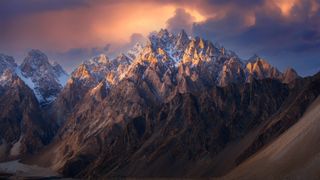
How do mountains form?
Mountains form in a variety of ways, some of which geologists are now just starting to understand.

Earth is speckled with mountains, from the slight Mount Wycheproof, rising 482 feet (147 meters) above sea level in Victoria, Australia, to the highest mountain on Earth, Mount Everest, standing 29,032 feet (8,849 meters) tall. But how do these puny to gigantic peaks form?
Mountains are born in a number of ways, many of which are linked to Earth's tectonic plates. When these giant slabs of rocks collide, their edges can buckle and fold, which forces rock up to form a mountain range. The Himalayas, which are home to Mount Everest, formed in this manner.
Sometimes, when tectonic plates meet, one ends up diving under the other — a phenomenon known as subduction. The rock that crumples up at the edges can give rise to mountain ranges such as the Andes, according to the University of California Museum of Paleontology.
Mountains can also form when tectonic plates split. The blocks of rock on each side of the resulting rift can form mountain ranges such as the Sierra Nevada in the western United States, the University of California Museum of Paleontology noted.
Volcanism is another way mountains can arise. Subduction zones often host volcanoes, leading to island arcs such as the isles of Japan, according to James Madison University's geology department. In addition, giant pillars of hot rock known as mantle plumes can rise from near Earth's core to sear overlying material like a blowtorch, forming volcanic islands such as the Galapagos.
Related: What's the highest a mountain can grow on Earth?
Curiously, erosion can help drive mountain growth as well. For instance, "glaciers or rivers running off the slope of mountains erode materials with them," Lijun Liu, a geoscientist at the University of Illinois Urbana-Champaign, told Live Science. This lifts weight off Earth's crust, driving the soft mantle underneath to rebound upward and leading mountain peaks to rise, he noted in a 2014 study.
Sign up for the Live Science daily newsletter now
Get the world’s most fascinating discoveries delivered straight to your inbox.
Moreover, geologists are discovering that activity deep within the Earth may play a role in building mountains, Jonny Wu, a geodynamicist at the University of Arizona in Tucson, told Live Science.
For example, recent findings suggest that chunks of dense rock can peel off the bottom of tectonic plates and fall into the mantle beneath it, which may cause the underlying surface to buoy upward, Liu said.
Such delamination could help explain how high mountains or plateaus can form within the interiors of continents, such as the Rocky Mountains and the Colorado Plateau, Liu said. It might also help explain high elevations in the Tibetan Plateau, Sean Gallen, a geomorphologist at Colorado State University in Fort Collins, told Live Science.
In addition, rock in the mantle churns on million-year timescales — a phenomenon known as dynamic topography, Wu said. This churning can warp Earth's surface upward, he noted. However, it remains debated how much dynamic topography can actually change Earth's surface, Gregory Ruetenik, a researcher at the Czech Academy of Sciences' Institute of Geophysics, noted in a 2023 commentary in the journal Nature Geoscience.
Furthermore, as subducting tectonic plates descend, they may interact with layers of the mantle or churning flows. These slab-mantle interactions can trigger a chain reaction that is felt at the surface, causing mountains to rise or fall, Wu said.
"Examples where these types of processes have been used to explain mountain-building histories include parts of the Andes and certain subduction zones in the Mediterranean," Gallen said.
All in all, "mountain building profoundly shapes the Earth on which we live," Wu said. Mountains influence climate and weather, and the erosion and weathering of sediments from mountain ranges have a significant chemical impact on the planet's surface, oceans and atmosphere, he explained.
Although mountains are important to life on Earth, "we still don't fully understand how they form and change through time," Gallen said. "That's why I find them so exciting to study."

Most Popular


